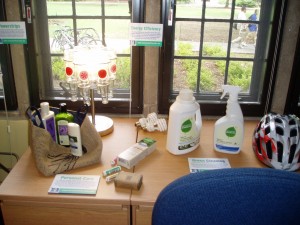 Does sustainability sound like a big topic for your daily life? Not at all! For my fellow college student friends, take a look around your dorm room. It may be able to only hold a few essential furnitures, such as beds, chairs, desks, closets. But since it is your home away from home, take on the responsibility with simple steps to make your room sustainable for our environment.
Does sustainability sound like a big topic for your daily life? Not at all! For my fellow college student friends, take a look around your dorm room. It may be able to only hold a few essential furnitures, such as beds, chairs, desks, closets. But since it is your home away from home, take on the responsibility with simple steps to make your room sustainable for our environment.
You can save energy by using…
-Smart Power Strip
When you turn off your laptop or close your microwave door, you think your electronics are just sleeping and not consuming any power. Look more closely, they are still sucking electricity out from outlets in order to support functions such as timers or remote control. Standby power is significant when accumulated. “The average U.S. household spends $100 per year to power devices while they are off (or in standby mode). On a national basis, standby power accounts for more than 100 billion kilowatt hours of annual U.S. electricity consumption and more than $10 billion in annual energy costs.”
A smart power strip is able to unplug devices that are plugged into the “Automatically Switched outlets” when they are turned off. The strip can prevent devices from drawing unnecessary current without people needing to unplug them. It saves both power and money for you!
-LED light bulbs
Check out this website http://eartheasy.com/live_led_bulbs_comparison.html, where you could learn about the comparison between LEDs, CFLs, and traditional Incandescents. Economically, the price tag of LEDs may seem discouraging, but due to their energy-efficiency and durability, the frequency of switching LED bulbs is significantly less than it is of incandescents. Environmentally, in addition to LEDs’ low energy consumption, they cause less heat in the space which results in less air conditioning need. Also, there is no mercury used in production of LEDs. Last but not least, less bulbs change means less waste being dealt with by our earth, especially when glass is often not recycled as effectively as other material, less bulbs means less glass waste. However, if you have any concerns about flickering of LEDs, this article should be able to help you minimize the issue. http://www.digikey.com/en/articles/techzone/2012/jul/characterizing-and-minimizing-led-flicker-in-lighting-applications
-Energy Efficient Appliances
Before you feel good about using appliances that are energy efficient, think about a simple math inequation: given that x is a positive number, x>0. Anything that is energy efficient still consumes more energy than not using it at all. So take a moment and think about do you really need your mini refrigerator just to cool your sodas? Do you really need your microwave, especially when it is available in your dorm kitchen, which may just be a bit far from your room? How often do you actually use your iron? If your answer is still yes, please visit this website: http://www.energystar.gov/certified-products/certified-products?c=products.pr_find_es_products, and use appliances that are Energy Star rated, meaning they are energy efficient.
On the other hand, you could plan it out with your roommate/roommates or even hall mates that each person brings one infrequently used electronic and everyone can share and utilize the aggregate resources, such as hair dryer, electrical iron, microwave, and printer.
-Drying Rack
Have you noticed how wrinkled your clothes is after going through dryers? What? I’m sorry to hear that your favorite cotton t-shirt just shrunk a size down…How about adding a drying rack to your to-pack list that will preserve your clothes and your headache of collecting quarters for dryers? Dryers are the third appliance that consume the most energy after refrigerators and washers. Hang dry your clothes on a drying rack only takes a bit more time and energy, but you are saving a lot of energy for the earth! If your friends are surprised about it when they come to your room, encourage them to do the same by sharing your rack with them (less consumption again!) On the same note, select cold water when use washers. New types of detergent is designed for cold-water use, which does the same job if not better than traditional detergent that requires hot water. Avoiding heating up water for washing clothes saves a lot of energy in this inevitable use of electronic appliance.
You will have less impact on the earth by using…
-Organic Bedding
Organic bedding are made with materials like organic cotton that does not have toxic chemical pesticide applied to them. While enjoying the extra soft and safe pillow and blanket, you are protecting the environment from exposing to toxics.
-Reusable Bags
It will be a bit redundant to list out all benefits of reusable bags. But how can one actually implement and help promote the idea? If you are a leader of an organization that is financially capable, consider investing in distributing reusable bags with cool designs during occasions such as orientation for new students. It not only encourages students to use less plastic bags, but also quietly publicize your organization. If you always forget to bring reusable bags for grocery shopping, try leave spare reusable bags in your car or place them around your door where you could easily see and remind yourself.
-Biodegradable laundry detergent, Biodegradable cleaning supplies
Take an advantage of today’s technology development, choose biodegradable laundry detergent to lower your impact on the environment. Stated on P&G website:” “Biodegradable laundry detergent lacks the chemical overload found commonly in standard detergent. Naturally derived cleansers replace the synthetic compounds that can cause environmental harm. This is especially important for homes with septic systems. Biodegradable laundry detergents decay at a normal rate into components inert to the environment, instead of soaking the yard with chemical runoff.” Other than environmental benefit, this kind of detergent is good for people who have sensitive skins and prone to rashes. Less toxic for the earth, and for you, why not?
Similarly, biodegradable cleaning supplies are made with natural ingredients that will be degraded more easily and less harmfully than conventional ones. This website will give you more information about what ingredients to avoid, or just make your own cleaning products with organic ingredients like vinegar! http://greenliving.lovetoknow.com/biodegradable-cleaning-products
-Personal Care Products
Do you buy a shampoo sometimes because of its pleasing scent? It might smell good, but it may be a result of toxic chemical additive. Many common personal hygiene products contain toxic chemicals that will enter the waste water and negatively affect the ecological system. Choosing organic personal care products is beneficial not only for your own health, also for adding less toxic to the water system. Thanks to a project done by previous CELL Group, here is a list of ingredients you should avoid: Ammonium lauryl ether sulfate Ammonium chloride Cocoamide DEA or MEA Cocamidopropyl betaine Lauramide DEA Methylisothiazolinone Parabens Parfum (fragrances) (Poly)ethylene glycols (PEGs) Quaternium-15 -siloxanes and -methicones.
Also, you could use http://www.ewg.org/skindeep to check the health ratings for your hygiene products.
To look for more examples and tips you could do to have a green dorm room, please visit:
http://sustainability.duke.edu/campus_initiatives/buildings/GrnDrmRm.html
http://www.housing.umass.edu/living/your_sustainable_room.html
http://www.bu.edu/sustainability/what-you-can-do/the-green-room/the-green-dorm/
I hope that this introduction of setting up a sustainable dorm room could serve to remind you that there is so many trivial aspects you could easily accomplish to contribute to a significant change for sustainability. Start small, start now, you can make a difference!
UB Qiu

